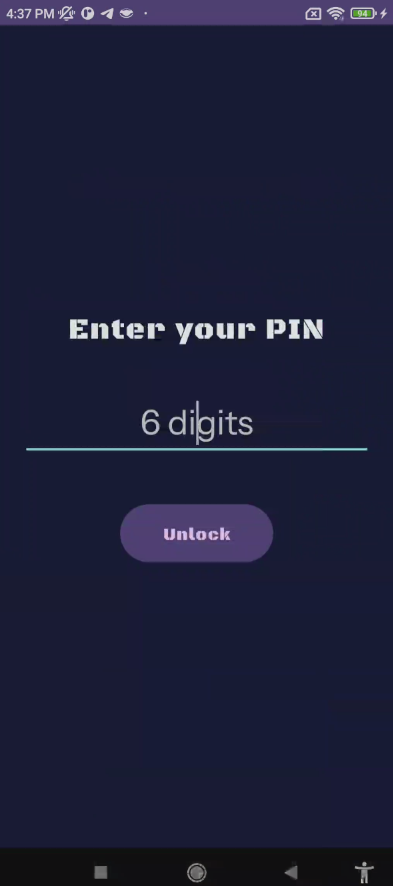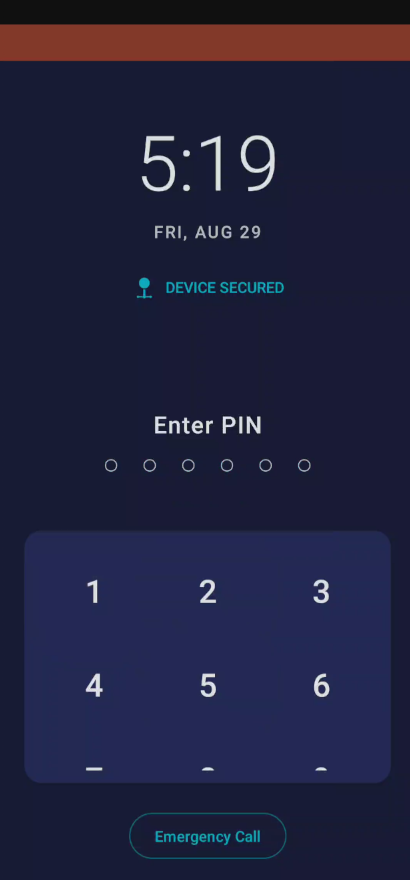8kSec - BorderDroid - International Border Protection¶
Description: Crossing international borders as a highly targeted individual? BorderDroid provides the ultimate protection against unauthorized device seizures and searches.
Link: https://academy.8ksec.io/course/android-application-exploitation-challenges
Install the .apk file using ADB.
Then, give all the needed permissions to the applications. An input text for 6 digits must be appear.
I set a 6 digits as 111111. Then, a new activity will be launched with three buttons.
-
Start Security
-
Stop Security
-
Change PIN
After set the PIN, and press start security button, we can see a countdown. And then, kiosk mode is activated.
I'm trying to put my code, but isn't work.
The kiosk mode, is working.
Let's analyze the source code using JADX.
The package name is com.eightksec.borderdroid.
And in the AndroidManifest.xml file we can see this receiver exported as true.
<receiver
android:name="com.eightksec.borderdroid.receiver.RemoteTriggerReceiver"
android:enabled="true"
android:exported="true">
<intent-filter>
<action android:name="com.eightksec.borderdroid.ACTION_PERFORM_REMOTE_TRIGGER"/>
</intent-filter>
</receiver>
And, we can see a lot of classes in the java code.
I'll show some interesting functions.
Using Volume Buttons¶
Starting in YouAreSecureActivity class, I found that never will work if we insert the correct pin, because always will call to showWrongPinError() function:
private void onNumpadClick(String str) {
this.wrongPinText.setVisibility(4);
if (this.enteredPin.length() < 6) {
this.enteredPin.append(str);
updatePinDots();
if (this.enteredPin.length() == 6) {
showWrongPinError();
}
}
}
So.. we can see another great function in this class, which is checkVolumeSequence()
private void checkVolumeSequence() {
while (this.volumeSequence.size() > this.targetSequence.size()) {
Log.d(TAG, "Trimming volume sequence (unexpectedly long). Old: " + this.volumeSequence.toString());
this.volumeSequence.remove(0);
}
if (this.volumeSequence.equals(this.targetSequence)) {
Log.i(TAG, "Target volume sequence DETECTED! Unlocking.");
this.volumeSequence.clear();
Runnable runnable = this.volumeSequenceTimeout;
if (runnable != null) {
this.volumeSequenceHandler.removeCallbacks(runnable);
}
unlockAndReturnToDashboard();
return;
}
if (this.volumeSequence.size() == this.targetSequence.size()) {
Log.d(TAG, "Volume sequence full but incorrect. Pruning first element. Seq: " + this.volumeSequence.toString());
this.volumeSequence.remove(0);
}
}
Which is used in onKeyDown() function:
public boolean onKeyDown(int i, KeyEvent keyEvent) {
if (i == 24 || i == 25) {
Log.d(TAG, "Volume key pressed: ".concat(i == 24 ? "UP" : "DOWN"));
resetSequenceTimeout();
this.volumeSequence.add(Integer.valueOf(i));
checkVolumeSequence();
return true;
}
return super.onKeyDown(i, keyEvent);
}
And finally, the unlockAndReturnToDashboard() function:
private void unlockAndReturnToDashboard() {
try {
Log.i(TAG, "Stopping lock task due to volume sequence.");
stopLockTask();
} catch (Exception e) {
Log.e(TAG, "Failed to stop lock task during unlock", e);
}
Log.i(TAG, "Disabling kiosk state and stopping HTTP service.");
setKioskState(false);
Log.i(TAG, "Navigating back to DashboardActivity.");
Intent intent = new Intent(this, (Class<?>) DashboardActivity.class);
intent.addFlags(603979776);
startActivity(intent);
finish();
}
unlockAndReturnToDashboard()→stopLockTask(),setKioskState(false), stopHttpUnlockServiceand openDashboardActivity.
But, what is the sequence?
Well, it's easy. In YouAreSecureActivity class, we can see the following list:
public YouAreSecureActivity() {
List<Integer> m65m;
m65m = YouAreSecureActivity$ExternalSyntheticBackport0.m65m(new Object[]{24, 25, 24, 25});
this.targetSequence = m65m;
this.volumeSequenceHandler = new Handler(Looper.getMainLooper());
}
The sequence: 24, 25, 24, 25.
Remember the onKeyDown() function?
Pay attention in these lines:
So:-
UP->24 -
DOWN->25
Sequence: UP, DOWN, UP, DOWN
In kiosk mode, just follow the sequence and the kiosk mode must be turned off!
HTTP Remote using PIN via Wi-Fi¶
We can see that the app set up a Nano HTTP Server locally.
Check it with:
Output:Let's check some classes, but the most important class is HttpUnlockService.
Ill put the entire class code:
public class HttpUnlockService extends Service {
public static final String ACTION_STOP_KIOSK = "com.eightksec.borderdroid.ACTION_STOP_KIOSK_ENFORCEMENT";
private static final String NOTIFICATION_CHANNEL_ID = "HttpUnlockServiceChannel";
private static final int NOTIFICATION_ID = 1;
private static final int SERVER_PORT = 8080;
private static final String TAG = "HttpUnlockService";
private WebServer server;
@Override // android.app.Service
public IBinder onBind(Intent intent) {
return null;
}
@Override // android.app.Service
public void onCreate() {
super.onCreate();
createNotificationChannel();
this.server = new WebServer(this);
}
@Override // android.app.Service
public int onStartCommand(Intent intent, int i, int i2) {
startForeground(1, new NotificationCompat.Builder(this, NOTIFICATION_CHANNEL_ID).setContentTitle("BorderDroid Kiosk Control").setContentText("Remote Unlock Listener Active").setSmallIcon(C0479R.drawable.ic_launcher_foreground).setContentIntent(PendingIntent.getActivity(this, 0, new Intent(this, (Class<?>) DashboardActivity.class), AccessibilityEventCompat.TYPE_VIEW_TARGETED_BY_SCROLL)).setOngoing(true).build());
try {
if (!this.server.isAlive()) {
this.server.start(NanoHTTPD.SOCKET_READ_TIMEOUT, false);
}
} catch (IOException unused) {
stopSelf();
}
return 1;
}
@Override // android.app.Service
public void onDestroy() {
super.onDestroy();
WebServer webServer = this.server;
if (webServer != null) {
webServer.stop();
}
stopForeground(true);
}
private void createNotificationChannel() {
if (Build.VERSION.SDK_INT >= 26) {
NotificationChannel notificationChannel = new NotificationChannel(NOTIFICATION_CHANNEL_ID, "HTTP Unlock Service Channel", 2);
NotificationManager notificationManager = (NotificationManager) getSystemService(NotificationManager.class);
if (notificationManager != null) {
notificationManager.createNotificationChannel(notificationChannel);
}
}
}
private static class WebServer extends NanoHTTPD {
private Context context;
private PinStorage pinStorage;
public WebServer(Context context) {
super(HttpUnlockService.SERVER_PORT);
this.context = context.getApplicationContext();
this.pinStorage = new PinStorage();
}
@Override // fi.iki.elonen.NanoHTTPD
public NanoHTTPD.Response serve(NanoHTTPD.IHTTPSession iHTTPSession) {
String str;
NanoHTTPD.Response.Status status = NanoHTTPD.Response.Status.OK;
if (NanoHTTPD.Method.POST.equals(iHTTPSession.getMethod()) && "/unlock".equalsIgnoreCase(iHTTPSession.getUri())) {
try {
try {
HashMap hashMap = new HashMap();
iHTTPSession.parseBody(hashMap);
String str2 = hashMap.get("postData");
if (str2 == null || str2.isEmpty()) {
str = "Error: Empty or unparseable request body. Send JSON with 'pin'.";
status = NanoHTTPD.Response.Status.BAD_REQUEST;
} else {
str = "";
}
if (status == NanoHTTPD.Response.Status.OK && str2 != null) {
String optString = new JSONObject(str2).optString("pin", null);
if (optString != null) {
broadcastVulnerableUnlockIntentWithPin(optString);
str = "Unlock attempt initiated (vulnerable pathway).";
status = NanoHTTPD.Response.Status.OK;
} else {
str = "Error: Missing 'pin' in JSON body.";
status = NanoHTTPD.Response.Status.BAD_REQUEST;
}
}
} catch (JSONException unused) {
status = NanoHTTPD.Response.Status.BAD_REQUEST;
str = "Error: Invalid JSON format.";
} catch (Exception e) {
Log.e(HttpUnlockService.TAG, "Unexpected error serving request", e);
status = NanoHTTPD.Response.Status.INTERNAL_ERROR;
str = "Error: Internal server error.";
}
} catch (NanoHTTPD.ResponseException | IOException unused2) {
status = NanoHTTPD.Response.Status.INTERNAL_ERROR;
str = "Error: Failed to read request body or socket error.";
}
} else {
Log.w(HttpUnlockService.TAG, "Received request for unsupported method/URI: " + iHTTPSession.getMethod() + " " + iHTTPSession.getUri());
status = NanoHTTPD.Response.Status.NOT_FOUND;
str = "Error: Unsupported request. Use POST to /unlock.";
}
return newFixedLengthResponse(status, NanoHTTPD.MIME_PLAINTEXT, str);
}
private void broadcastVulnerableUnlockIntentWithPin(String str) {
Intent intent = new Intent(RemoteTriggerReceiver.ACTION_PERFORM_REMOTE_TRIGGER);
intent.putExtra(RemoteTriggerReceiver.EXTRA_TRIGGER_PIN, str);
intent.setClassName(this.context, RemoteTriggerReceiver.class.getName());
this.context.sendBroadcast(intent);
Log.i(HttpUnlockService.TAG, "Broadcast sent for remote trigger: " + intent.getAction());
}
}
}
Notice the port number:
And the endpoint:
public NanoHTTPD.Response serve(NanoHTTPD.IHTTPSession iHTTPSession) {
String str;
NanoHTTPD.Response.Status status = NanoHTTPD.Response.Status.OK;
if (NanoHTTPD.Method.POST.equals(iHTTPSession.getMethod()) && "/unlock".equalsIgnoreCase(iHTTPSession.getUri())) {
So, we have:
POST http://192.168.0.124:8080/unlock
And finally, we have the body content!
if (status == NanoHTTPD.Response.Status.OK && str2 != null) {
String optString = new JSONObject(str2).optString("pin", null);
if (optString != null) {
broadcastVulnerableUnlockIntentWithPin(optString);
str = "Unlock attempt initiated (vulnerable pathway).";
status = NanoHTTPD.Response.Status.OK;
} else {
str = "Error: Missing 'pin' in JSON body.";
status = NanoHTTPD.Response.Status.BAD_REQUEST;
}
pin! If we send the correct PIN, this function will be triggered:
broadcastVulnerableUnlockIntentWithPin(), passed the PIN as extra:
private void broadcastVulnerableUnlockIntentWithPin(String str) {
Intent intent = new Intent(RemoteTriggerReceiver.ACTION_PERFORM_REMOTE_TRIGGER);
intent.putExtra(RemoteTriggerReceiver.EXTRA_TRIGGER_PIN, str);
intent.setClassName(this.context, RemoteTriggerReceiver.class.getName());
this.context.sendBroadcast(intent);
Log.i(HttpUnlockService.TAG, "Broadcast sent for remote trigger: " + intent.getAction());
}
RemoteTriggerReceiver will be called with intents! When it's receive the intent, will execute this code:
public void onReceive(Context context, Intent intent) {
String stringExtra;
if (!ACTION_PERFORM_REMOTE_TRIGGER.equals(intent.getAction()) || (stringExtra = intent.getStringExtra(EXTRA_TRIGGER_PIN)) == null || stringExtra.isEmpty()) {
return;
}
try {
if (new PinStorage().verifyPin(context, stringExtra)) {
performUnlockActions(context);
return;
}
Bundle extras = intent.getExtras();
if (extras != null) {
for (String str : extras.keySet()) {
}
}
} catch (Exception unused) {
}
}
Look at:
Will verify the PIN with the extra string.And then, call performUnlockActions() function:
private void performUnlockActions(final Context context) {
Log.i(TAG, "Executing performUnlockActions...");
new Handler(context.getMainLooper()).post(new Runnable() { // from class: com.eightksec.borderdroid.receiver.RemoteTriggerReceiver$ExternalSyntheticLambda0
@Override // java.lang.Runnable
public final void run() {
RemoteTriggerReceiver.lambda$performUnlockActions$0(context);
}
});
}
static /* synthetic */ void lambda$performUnlockActions$0(Context context) {
Toast.makeText(context, "Remote Action Triggered (PIN OK)", Toast.LENGTH_SHORT).show();
context.getSharedPreferences("kiosk_state", 0).edit().putBoolean("is_kiosk_active", false).apply();
LocalBroadcastManager.getInstance(context).sendBroadcast(new Intent(HttpUnlockService.ACTION_STOP_KIOSK));
Log.d(TAG, "Sent local broadcast to stop kiosk enforcement: com.eightksec.borderdroid.ACTION_STOP_KIOSK_ENFORCEMENT");
Log.i(TAG, "Requesting stop of HttpUnlockService from RemoteTriggerReceiver.");
context.stopService(new Intent(context, (Class<?>) HttpUnlockService.class));
Intent intent = new Intent(context, (Class<?>) DashboardActivity.class);
intent.addFlags(Intent.FLAG_ACTIVITY_NEW_TASK);
context.startActivity(intent);
Log.i(TAG, "Finished executing unlock actions within Handler.");
}
How we can abuse of this vulnerability?
Simple, just brute forcing the PIN via Request.
But just for be a little concise, Ill show you the curl command.
curl -i -X POST http://192.168.0.6:8080/unlock \
-H 'Content-Type: application/json' \
-d '{"pin":"111111"}'
I hope you found it useful (:

